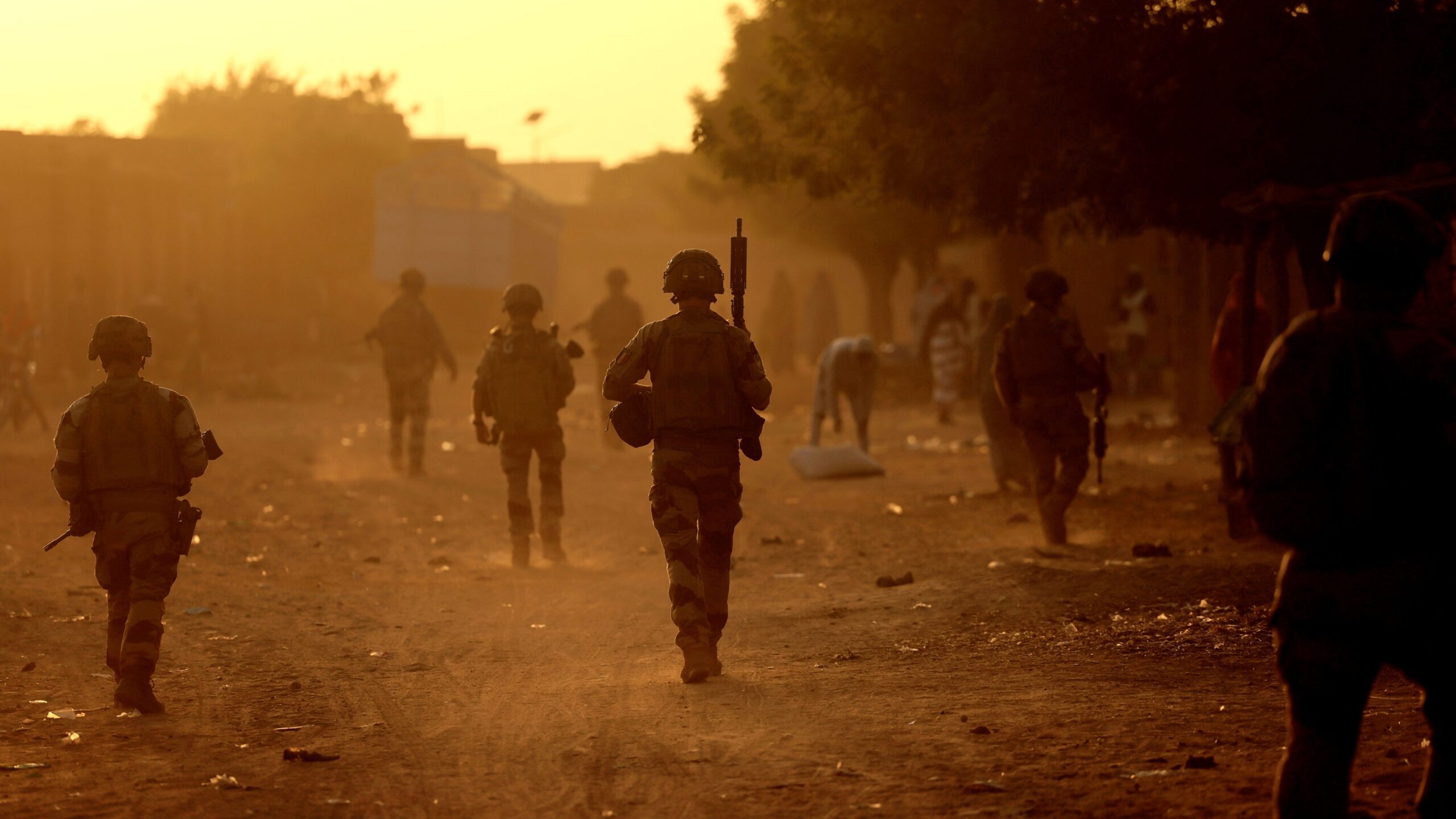
French soldiers patrol the streets of Gao on December 4, 2021. (THOMAS COEX/AFP via Getty Images)
PARIS — In the wake of Russia’s invasion of Ukraine, France’s military intelligence agency is undergoing a series of reforms to try and close coordination gaps and stay ahead of future military activities, whether in Europe or elsewhere in the world, a top officer tells Breaking Defense.
French Maj. Gen. Cyril Carcy is a former Defense Attaché to the embassy in Washington and now serves as Deputy Director of the French Military Intelligence Directorate (DRM for “Direction du renseignement militaire”). He told Breaking Defense in a recent interview that the Ukraine conflict has forced a broadening of his office’s focus areas.
“Reinforced since February 24th, 2022, we no longer focus on a 60-degree angle between Western Africa and the Middle-East dictated by the fight against terrorism, but we constantly look around with a 360-degree spectrum, not only geographically-speaking, but also with the integration of space, cyber and underwater domains,” Carcy said.
Preparing for Multi-Domain Operations (MDO) means being able to provide multi-domain anticipation and connectivity. “Producing upgraded intelligence of military interest” in the fastest and most accurate way possible is the goal of the DRM, Carcy said, which is helping drive a series of reforms in the agency.
In addition to the above-mentioned change of focus, one major shift is connecting collection experts and data-miners on the one hand, and analysts on the other hand, into “intelligence fusion cells” that should provide a more organic intelligence assessment. Until a few months ago, those two categories of personnel were geographically split between the Air Force base of Creil outside Paris (for the dataminers) and the Ministry of the Armed forces located in Balard in the center of the capital (for the analysts).
There are still a lot of challenges associated with the reform — such as human resources restructuring and IT system modernization — but results are already being felt in terms of the quality and speed of delivery of the intelligence provided and its impact on the success of operations.
Change is driven by the DRM’s belief that one of the biggest lessons from the Ukraine conflict is the importance of good intelligence for efficient Command and Control (C2) for accurate targeting as well as strategic communication — both part of deterrence and useful for de-escalation purposes. avoiding escalation.
Carcy highlighted the fact that Ukraine’s success so far has been reliant on a structured C2 and incredible agility, in addition to Western long-range equipment (such as the U.S. HIMARS and the French Caesars) and Western intelligence. Russia, on the other hand, has suffered from the outset from a lack of precision targeting and an inability to anticipate.
“If Russia has a genuine strategic depth on its own, especially crucial as far as the regeneration of its military equipment and troops is concerned, Ukraine has been benefitting from the strategic depth the support of some fifty-plus states brings to the battlefield,” Carcy said.
The future will tell, but the 2022 Ukrainian campaign might serve for Russian military planners as a wake up call for having good and reliable intelligence — a lesson the French took away from the first Gulf War. Indeed, it was a lack of both large-scale operations and joint organization the French armed forces experienced in that conflict that prompted the creation of the DRM in 1992, as well as the massive investments made since then in space-based capabilities.
In the past thirty years, the ability to exploit the information gathered from a wide variety of sources — or “strategic sensors,” as Carcy calls pathways like ELINT, SIGINT, IMINT/GEOMINT and HUMINT) — in order to provide reliable and verifiable intelligence changed the dynamic of operations, as well as the relations of the French military with its allies, especially with the United States. While France is not part of the Five Eyes intelligence sharing pact, bilateral exchanges of information at the highest classified level now occur between Paris and Washington on a regular basis via the Lafayette Committee created in the aftermath of the Bataclan terrorist attacks in 2015.
“Western allies are particularly attentive to the high intensity war occurring in Ukraine. This accurate observation will undeniably lead to an update of the TTPs [Tactics, Training and Procedures] accordingly to favor more flexibility, more agility, more C2 decentralization, more redundancy, more stocks, more mass — indeed, as the famous saying attributed to Joseph Stalin goes ‘quantity has a quality all its own’ — and so on,” Carcy said.
Ultimately, however, Carcy came back to the idea his department needs a “360 degree” view of the world — and that includes not getting locked just on Ukraine, as important as that ongoing conflict is.
“The concern is of course that the longer this war of attrition lasts, the more it will benefit Moscow, while the undermining of the global order and balance exacerbates conquering prospects and temptations by competitive players on the international scene, endangering not only our homelands, but also our overseas territories” he said. “This is why it is absolutely essential to ‘zoom out’ from Ukraine, so we are not overtaken by surprise.”
Among the issues DRM is keeping track of: “the Wagner Group’s predation strategy in Central Africa and in Mali; Russia’s circumvention of western sanctions; Russia’s efforts to find suppliers of artillery ammunition [and] Russian military activity outside Ukraine,” Carcy said.
Army eyes TBI monitoring, wearable tech for soldiers in high-risk billets
“We are also looking at what additional personal protective equipment we can provide to our folks, especially instructors and others who are routinely exposed to blast pressure,” said Army Secretary Christine Wormuth.


























